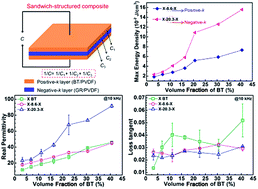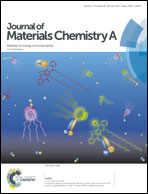Significantly improved dielectric performances of sandwich-structured polymer composites induced by alternating positive-k and negative-k layers†
Abstract
High-k polymer composites are promising candidates for energy-storage capacitors and many other electronic devices. However, balancing the permittivity, loss and breakdown strength remains a challenge for us. Herein, theoretical calculations and experimental studies were simultaneously carried out to develop an original design of sandwich-structured composites consisting of alternating negative-k and positive-k layers toward high performance dielectric applications. It is experimentally proved that the trilayered composites are capable of balancing the two contrasting parameters of permittivity and loss. The introduction of negative-k layers into trilayered composites leads to a higher dielectric constant (ε′ ≈ 90@10 kHz) and low retained loss (tan δ ≈ 0.025@10 kHz) compared with those of the pristine PVDF (ε′ ≈ 10@10 kHz, tan δ ≈ 0.020@10 kHz). Moreover, the trilayered composites possess an obviously improved energy-storage capacity which is nearly 3 times higher than those of traditional trilayered composites without negative-k layers. Although the permittivity boost effect is still far below the theoretically predicted results and the mechanisms need to be further clarified, these results undoubtedly validated the feasibility of our design, and multilayer high-k composites with fascinating dielectric performances are expected to emerge in the near future via tailoring the properties of single layers and stacking sequences.

- This article is part of the themed collection: 2017 Journal of Materials Chemistry A HOT Papers


 Please wait while we load your content...
Please wait while we load your content...